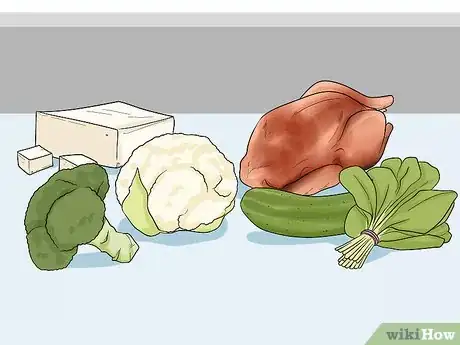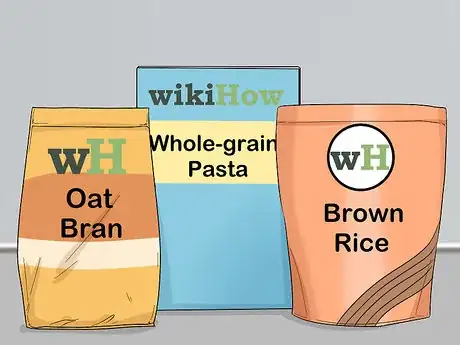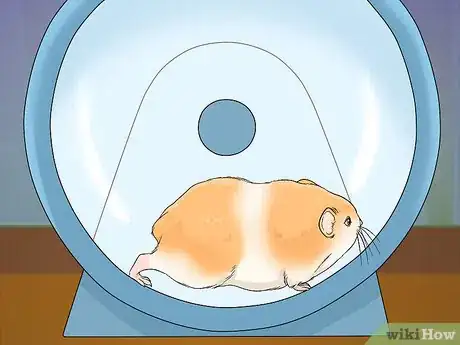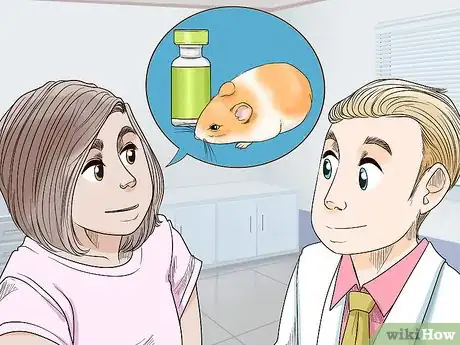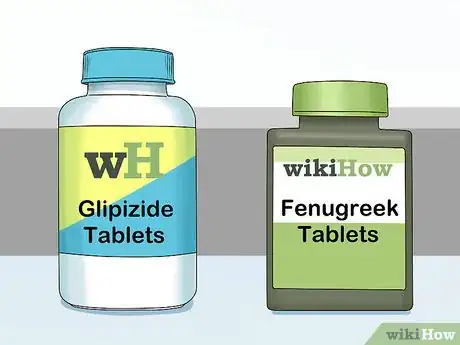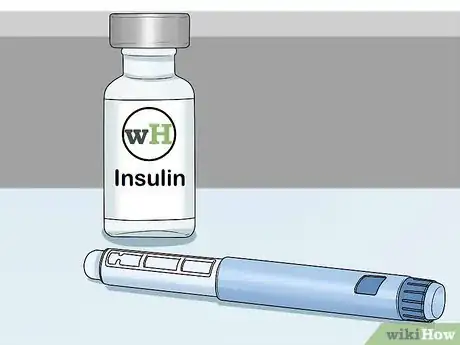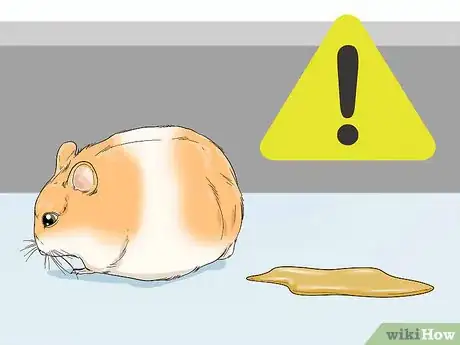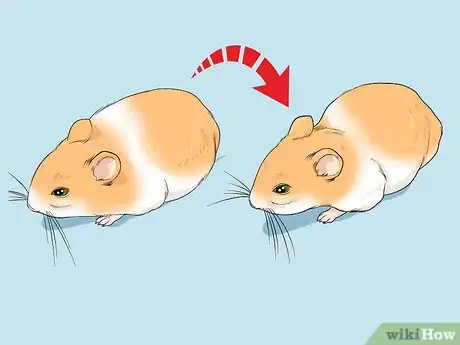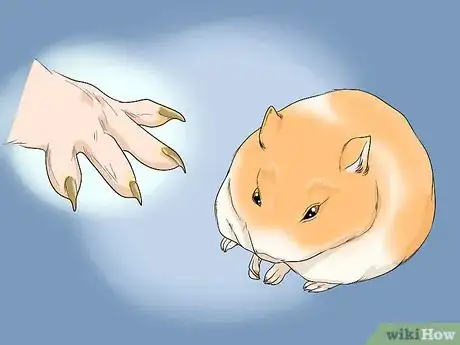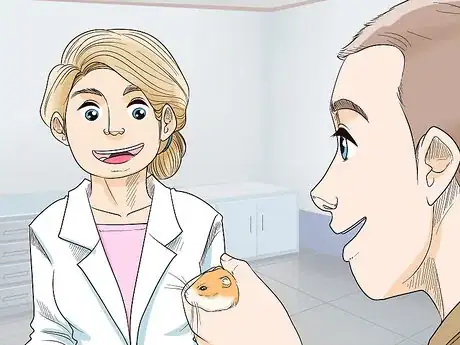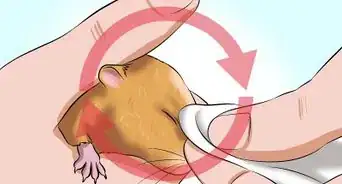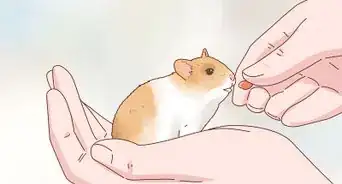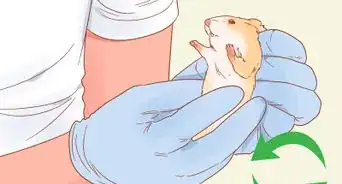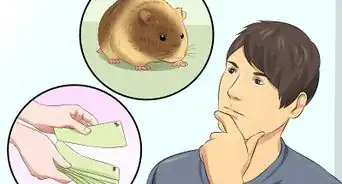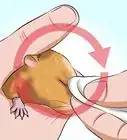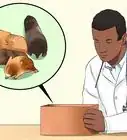This article was co-authored by Pippa Elliott, MRCVS. Dr. Elliott, BVMS, MRCVS is a veterinarian with over 30 years of experience in veterinary surgery and companion animal practice. She graduated from the University of Glasgow in 1987 with a degree in veterinary medicine and surgery. She has worked at the same animal clinic in her hometown for over 20 years.
This article has been viewed 32,452 times.
Diabetes can occur in a number of hamster species, but it is most common among dwarf hamsters. Diabetes is a serious health issue, but don't worry! It can be managed through a combination of diet and medication. If you suspect your hamster has diabetes, you should test their urine and seek medical attention. Your vet will likely suggest a diet with reduced sugars and higher protein and fiber content. They may also suggest medical treatment, such as insulin.
Steps
Changing its Diet and Exercise
-
1Switch to low sugar foods. If your hamster has diabetes, it will be difficult for them to break down and convert sugar to energy. As a result, you should read the ingredients on your current hamster feed and check for added sugars, such as molasses, sugar cane, corn syrup, or fructose. If the food contains these sugars, you should change their food to a low sugar feed.[1]
- There is no special diabetic food mix on the market for hamsters, but you can ask your vet to recommend a food mix for your diabetic hamster.
-
2Avoid giving sugary treats. Sugary treats, such as fresh fruits, processed treats, and even carrots are difficult for a diabetic hamster to break down. Instead, try giving it washed and cut celery, broccoli, or spinach as a treat.
- Only give your hamster one treat per day and make sure to remove the treat from the cage if it is not consumed within a day. Fresh vegetables may rot.[2]
Advertisement -
3Feed your hamster a high protein and high fiber diet. Diabetic hamsters should eat a diet made up of 10-15% protein and 50% fiber. You can supplement their regular hamster feed by giving them sources of protein, such as plain tofu, cooked chicken and turkey, or scrambled egg. These should be given in small amounts daily. Some fiber sources include:
- Alfalfa.
- Timothy hay.
- Vegetables such as broccoli, cucumber, cauliflower, and spinach.
-
4Give your hamster complex carbs. Carbohydrates should be reduced but not completely removed from their diet. When giving hamsters carbohydrates, always choose complex carbs, such as oat bran, whole-grain pasta, and brown rice. Most hamster food mixes will contain an adequate amount of carbohydrates, ask your vet if you should supplement the food with complex carbs.
-
5Ensure your hamster exercises regularly. Regular exercise can also help to prevent and manage diabetes in hamsters. Make sure that your hamster has lots of space to move around their cage. You should also give them access to a running wheel. This can delay the onset of diabetes in some hamsters.
- Make sure to purchase a running wheel that is plastic or mesh to reduce the chances of injury. If your hamster's back bends while running on the wheel, you need to get a larger wheel.
- Hamster balls can also be a great form of exercise if used correctly. Make sure the ball is clear and that the area is carpeted. You should always watch the hamster while using an exercise ball.
Giving Your Hamster Medications
-
1Talk with your vet about treatment options. There are some medications that have been successful for treating diabetes in hamsters. Medical treatment of diabetes can be risky because the wrong dose could lead to serious health complications and even death. Ask your vet if there are any medical treatments that are suitable for your hamster's specific health needs.[3]
- You should consider the cost associated with different types of treatment when making your decision.
-
2Try oral medications. Glipizide and Fenugreek are common oral medications for treating diabetes in hamsters. Both of these treatment options are administered orally and will need to be prescribed by a vet. To administer, follow the instructions provided by your vet.
- Glipizide tablets are usually ground up and mixed with water and then fed to the hamster.
- Fenugreek comes in tablets or powder that are crushed and brewed into a tea and then fed to the hamster. It can be difficult to control the dose.
- Keep in mind that there are possible complications associated with these oral medications, including comas. Talk to your vet about the risks before your hamster starts treatment.
-
3Use insulin injections. Insulin can be purchased over the counter, but you should speak with a vet about proper dosage and how to administer the injections. The injections will likely be given twice a day. However, your vet may need to adjust the dosage based on how your hamster responds.
- If you choose to give your hamster insulin, it will need to have its blood tested weekly to see how it is responding to the medication.[4]
- Because hamsters are so small, it can be difficult to find the right insulin dosage to use. Talk to your vet about precautions you can take to avoid accidentally overdosing your hamster.
Diagnosing Diabetes
-
1Look for excessive drinking and urination. One of the first signs of diabetes in hamsters is excessive urination. For example, you may notice that the area of their cage used for urination is constantly wet. This excessive urination is also accompanied by excessive drinking, and you will likely be filling their water more frequently. This is a potential sign that your hamster has diabetes.
- Hamsters with diabetes will also eat more, but this can be challenging to notice because even healthy hamsters hoard food.
- Keep in mind that excessive drinking and urination could be a sign of a different health problem that isn't diabetes.
-
2Notice if your hamster loses weight quickly. Hamsters with diabetes, despite eating and drinking more than normal, will lose weight rapidly. Weigh your hamsters once a day if you suspect that they may have diabetes. If it has lost 10% or more of its body weight in a short period of time, it may have diabetes.
- Place your hamster on a kitchen scale at the same time each day in order to weigh it.
- Weight loss in your hamster could also be a sign of a different health issue other than diabetes.
-
3Check for yellow nails. The appearance of thick yellow nails is relatively easy to see and often indicates that your hamster has diabetes. That being said, yellow nails can be common in hamsters. Don't rely on this symptom alone when diagnosing a hamster with diabetes. Instead, test your hamster for diabetes if yellow nails develop.
-
4Test its urine for glucose. You can diagnose your hamster for diabetes at home using Keto-Diastix test strips. These can be purchased at your local pharmacy. Simply place your hamster in a small enclosure with no bedding. When the hamster urinates, dip the test strip in the urine. The strip will change colours. Compare the strip to the information on the package to see if your hamster has diabetes.
- It should not take longer than 20 minutes for a diabetic hamster to urinate.
- If your hamster does not urinate within 20 minutes, return it to its cage and try again later.
-
5Take your hamster to the vet. If your hamster tests positive for diabetes, you should take it to the vet to discuss treatment options. Your vet will likely ask you to change their diet and may suggest other medical options depending on the age and health of your hamster.
- If your hamster is showing signs of diabetes, but a urine test comes back negative, you should still seek medical attention. They may have another health issue that needs treatment.
Expert Q&A
-
QuestionAre Syrian hamsters prone to diabetes?
 Pippa Elliott, MRCVSDr. Elliott, BVMS, MRCVS is a veterinarian with over 30 years of experience in veterinary surgery and companion animal practice. She graduated from the University of Glasgow in 1987 with a degree in veterinary medicine and surgery. She has worked at the same animal clinic in her hometown for over 20 years.
Pippa Elliott, MRCVSDr. Elliott, BVMS, MRCVS is a veterinarian with over 30 years of experience in veterinary surgery and companion animal practice. She graduated from the University of Glasgow in 1987 with a degree in veterinary medicine and surgery. She has worked at the same animal clinic in her hometown for over 20 years.
Veterinarian Although dwarf hamsters have the highest incidence of diabetes, this is still very low. A Syrian hamster that is fed an appropriate diet, and not given lots of sugary snacks, is at extremely low risk of developing diabetes.
Although dwarf hamsters have the highest incidence of diabetes, this is still very low. A Syrian hamster that is fed an appropriate diet, and not given lots of sugary snacks, is at extremely low risk of developing diabetes. -
QuestionHow much does a hamster drink per day?
 Pippa Elliott, MRCVSDr. Elliott, BVMS, MRCVS is a veterinarian with over 30 years of experience in veterinary surgery and companion animal practice. She graduated from the University of Glasgow in 1987 with a degree in veterinary medicine and surgery. She has worked at the same animal clinic in her hometown for over 20 years.
Pippa Elliott, MRCVSDr. Elliott, BVMS, MRCVS is a veterinarian with over 30 years of experience in veterinary surgery and companion animal practice. She graduated from the University of Glasgow in 1987 with a degree in veterinary medicine and surgery. She has worked at the same animal clinic in her hometown for over 20 years.
Veterinarian Hamsters drink relatively little, around 1/2 to 2 teaspoons of water a day. However, they should always have access to clean drinking water, even if they don't appear to drink much.
Hamsters drink relatively little, around 1/2 to 2 teaspoons of water a day. However, they should always have access to clean drinking water, even if they don't appear to drink much. -
QuestionDo dwarf hamsters drink a lot of water?
 Pippa Elliott, MRCVSDr. Elliott, BVMS, MRCVS is a veterinarian with over 30 years of experience in veterinary surgery and companion animal practice. She graduated from the University of Glasgow in 1987 with a degree in veterinary medicine and surgery. She has worked at the same animal clinic in her hometown for over 20 years.
Pippa Elliott, MRCVSDr. Elliott, BVMS, MRCVS is a veterinarian with over 30 years of experience in veterinary surgery and companion animal practice. She graduated from the University of Glasgow in 1987 with a degree in veterinary medicine and surgery. She has worked at the same animal clinic in her hometown for over 20 years.
Veterinarian A healthy dwarf hamster should not seem thirsty. They would normally drink around 1/4 to 1/2 of a teaspoon of water per day.
A healthy dwarf hamster should not seem thirsty. They would normally drink around 1/4 to 1/2 of a teaspoon of water per day.
Warnings
- Do not breed a hamster that has diabetes. It can be passed down to their offspring.⧼thumbs_response⧽
References
About This Article
To deal with diabetes in hamsters, start by feeding your hamster a diet of alfalfa, timothy hay, and vegetables, like broccoli, cucumber, cauliflower, and spinach. Aim for meals that consist of 10-15% protein and 50% fiber. Next, make sure your hamster's cage provides plenty of space for it to move around and install an exercise wheel so it can get more physical activity. It's also important to avoid giving your hamster sugary treats, like fresh fruit, processed treats, and carrots. To learn more about the dietary needs of a diabetic hamster, read on!


